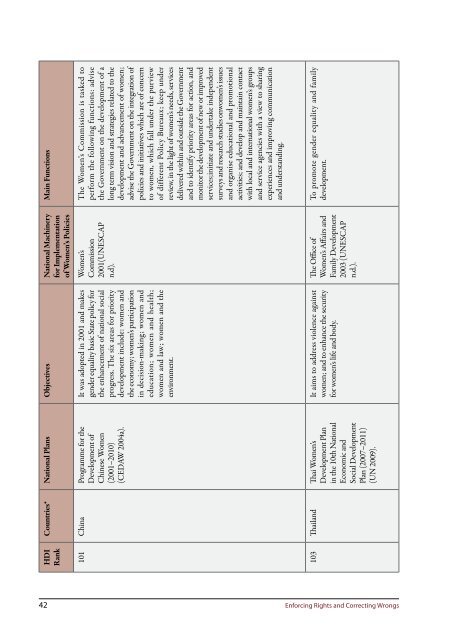Enforcing Rights and Correcting Wrongs - Asia-Pacific Regional ...
Enforcing Rights and Correcting Wrongs - Asia-Pacific Regional ...
Enforcing Rights and Correcting Wrongs - Asia-Pacific Regional ...
You also want an ePaper? Increase the reach of your titles
YUMPU automatically turns print PDFs into web optimized ePapers that Google loves.
Main Functions<br />
Countries* National Plans Objectives National Machinery<br />
for Implementation<br />
of Women’s Policies<br />
HDI<br />
Rank<br />
The Women’s Commission is tasked to<br />
perform the following functions: advise<br />
the Government on the development of a<br />
long term vision <strong>and</strong> strategies related to the<br />
development <strong>and</strong> advancement of women;<br />
advise the Government on the integration of<br />
policies <strong>and</strong> initiatives which are of concern<br />
to women, which fall under the purview<br />
of different Policy Bureaux; keep under<br />
review, in the light of women’s needs, services<br />
delivered within <strong>and</strong> outside the Government<br />
<strong>and</strong> to identify priority areas for action, <strong>and</strong><br />
monitor the development of new or improved<br />
services;initiate <strong>and</strong> undertake independent<br />
surveys <strong>and</strong> research studies onwomen’s issues<br />
<strong>and</strong> organise educational <strong>and</strong> promotional<br />
activities; <strong>and</strong> develop <strong>and</strong> maintain contact<br />
with local <strong>and</strong> international women’s groups<br />
<strong>and</strong> service agencies with a view to sharing<br />
experiences <strong>and</strong> improving communication<br />
<strong>and</strong> underst<strong>and</strong>ing.<br />
Women’s<br />
Commission<br />
2001(UNESCAP<br />
n.d).<br />
It was adopted in 2001 <strong>and</strong> makes<br />
gender equality basic State policy for<br />
the enhancement of national social<br />
progress. The six areas for priority<br />
development include: women <strong>and</strong><br />
the economy; women’s participation<br />
in decision-making; women <strong>and</strong><br />
education; women <strong>and</strong> health;<br />
women <strong>and</strong> law; women <strong>and</strong> the<br />
environment.<br />
101 China Programme for the<br />
Development of<br />
Chinese Women<br />
(2001–2010)<br />
(CEDAW 2004a).<br />
To promote gender equality <strong>and</strong> family<br />
development.<br />
The Office of<br />
Women’s Affairs <strong>and</strong><br />
Family Development<br />
2003 (UNESCAP<br />
n.d.).<br />
It aims to address violence against<br />
women; <strong>and</strong> to enhance the security<br />
for women’s life <strong>and</strong> body.<br />
103 Thail<strong>and</strong> Thai Women’s<br />
Development Plan<br />
in the 10th National<br />
Economic <strong>and</strong><br />
Social Development<br />
Plan (2007–2011)<br />
(UN 2009).<br />
42 <strong>Enforcing</strong> <strong>Rights</strong> <strong>and</strong> <strong>Correcting</strong> <strong>Wrongs</strong>


